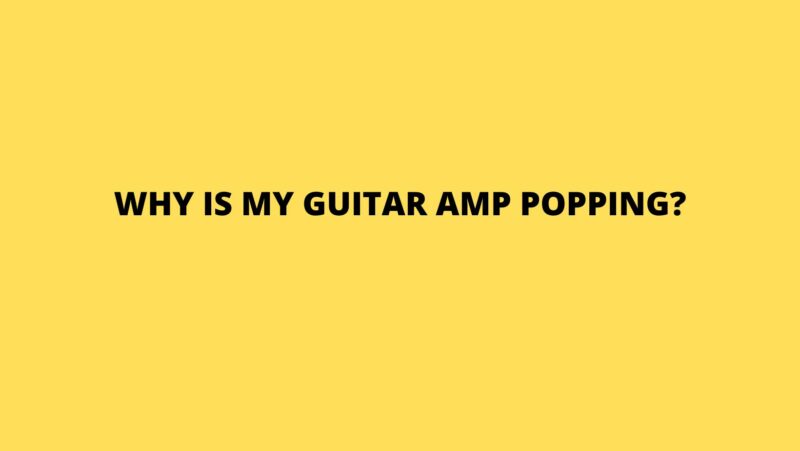Guitar amplifiers stand as the conduits through which musical magic flows, turning strings into symphonies. However, within this realm of amplified melodies, an unexpected interlude often takes center stage—the popping noise. These abrupt, startling sounds can disrupt the harmonious flow of your music and lead to perplexing moments of wonder. In this article, we embark on a journey to unveil the mystery behind popping noises in guitar amplifiers, diving into their origins, and equipping you with the understanding to decipher, address, and potentially prevent these sonic surprises.
Popping Noises: A Discordant Intrusion
Popping noises in guitar amplifiers are characterized by sudden, sharp bursts of sound that occur during various amplifier operations. These pops can manifest when turning the amplifier on or off, engaging or disengaging switches, or making adjustments to the controls. While often a mere annoyance, understanding the sources of these noises can help you regain control over your amplifier’s sonic landscape.
Deconstructing the Culprits of Popping Noises
To effectively grasp the complexity of popping noises and work towards their resolution, it’s essential to uncover the multifaceted factors that contribute to their occurrence:
- DC Offset Imbalance: DC offset refers to a discrepancy between the positive and negative portions of an audio waveform. This imbalance can lead to sudden voltage changes that materialize as popping noises when certain amplifier components are activated or deactivated.
- Tube Amplifier Transitions: In tube amplifiers, popping noises can emerge as tubes transition from their idle state to active operation. These voltage shifts, occurring as tubes warm up or cool down, contribute to the popping phenomenon.
- Mechanical Switches and Components: The physical act of engaging or disengaging switches, such as the power switch or standby switch, can generate mechanical pops. Similarly, mechanical components within the amplifier can lead to audible pops when manipulated.
- Capacitor Charging and Discharging: Some amplifiers might produce popping noises as capacitors charge or discharge during various operations. This occurrence is particularly common in amplifiers with larger or older capacitors.
- Signal Path Interruptions: Rapid changes in the signal path, like plugging or unplugging cables or engaging effects pedals, can result in popping noises as the audio path is suddenly interrupted or re-established.
Strategies to Conquer the Popping Puzzle
- Tube Amplifier Warm-Up: In tube amplifiers, allowing the tubes to warm up before engaging them fully can minimize sudden voltage changes that contribute to popping noises during the warm-up phase.
- Sequential Power On/Off: When powering your amplifier on or off, follow a sequential approach. Start by turning on the amplifier, allowing tubes to warm up, and then proceed to engage switches or connect instruments.
- Gentle Switch Handling: When engaging or disengaging switches, adopt a gentle approach without abrupt or forceful movements. Gradual action can help mitigate the mechanical popping phenomenon.
- Signal Path Management: Employing buffer pedals or noise gate pedals in your signal chain can assist in managing abrupt signal path changes, thus reducing popping noises during cable plugging/unplugging.
- Capacitor Upgrade Consideration: For amplifiers prone to capacitor-related popping noises, consider seeking professional advice on upgrading to high-quality, low-noise capacitors.
- Maintenance and Professional Servicing: Regular maintenance and professional servicing can aid in identifying and rectifying issues that lead to popping noises. Components such as switches and capacitors can be inspected and replaced, if necessary.
- DC Offset Adjustment: If popping noises are linked to DC offset imbalance, consulting a skilled technician to adjust bias settings can help mitigate this issue and minimize popping noises.
Diagnosis and Troubleshooting
- Source Isolation: Begin by isolating the source of popping noise. Test the amplifier with various cables, instruments, and input sources to determine if the issue is consistent or specific to particular conditions.
- Tube Examination: In tube amplifiers, inspect tubes for signs of wear or malfunction. Worn-out or faulty tubes can contribute to popping noises.
- Switch Assessment: Inspect the physical switches on your amplifier for signs of wear, damage, or inconsistencies. Cleaning or replacing switches exhibiting issues can address popping noises.
- Capacitor Inspection: For amplifiers with capacitor-related popping noises, inspect capacitors for signs of damage, aging, or leakage. Upgrading capacitors might be a viable solution.
- DC Offset Measurement: Seek assistance from a technician to measure DC offset in your amplifier. Addressing voltage imbalances can often eliminate or mitigate popping noises.
Conclusion
Popping noises in guitar amplifiers might initially appear as an enigma, but armed with knowledge and a systematic approach, you can unravel this sonic puzzle. By delving into the intricate factors that contribute to these noises and implementing strategic solutions, you can regain control over the sound of your amplifier. Remember, the journey to resolving popping noises extends beyond the technical realm, leading to a deeper understanding of the interplay between technology and artistic expression. With patience and informed actions, you can restore the harmonious and uninterrupted soundscape to your amplifier, allowing your musical journey to resonate with clarity and brilliance.


